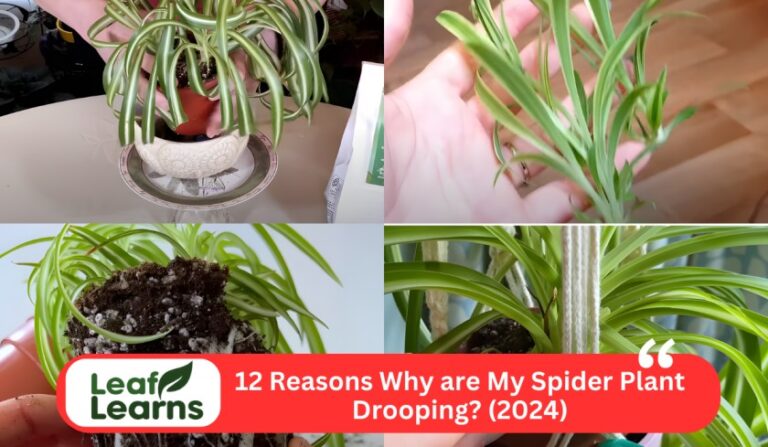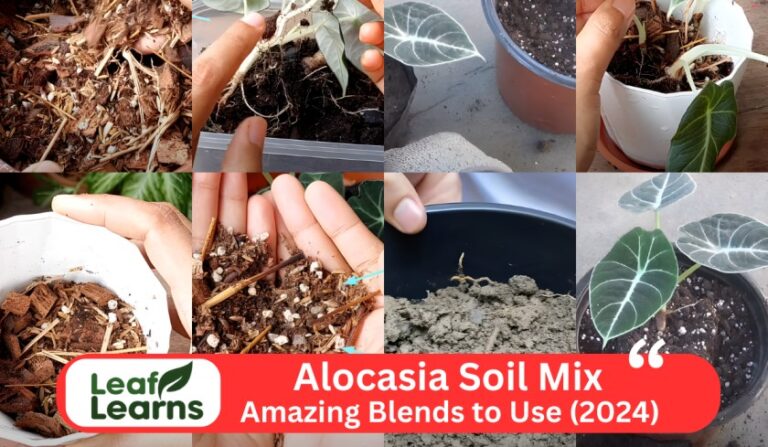What Causes Brown Spot on Snake Plant (2024)
Brown spot on snake plants can stem from a variety of factors, including fungal diseases, pests, and improper watering practices. Overwatering or underwatering, chlorinated water, excessive sunlight, and extreme temperatures can exacerbate the issue. Additionally, over-fertilization and pest infestations contribute to the formation of brown spots.

Applying a copper-based fungicide to fight fungal infections and using chemical or natural insecticides to get rid of pests are essential to addressing these issues.
Brown stains on snake plants may be avoided with proper care techniques include modifying watering schedules, making sure drainage is adequate, offering strong indirect sunshine, and keeping humidity levels stable.
Contents
Why Does Brown Spot on Snake Plant?
Overwatering
A typical cause of brown spot on snake plants is overwatering. Consistently damp soil promotes fungal infections and root rot, which show up as ugly brown patches on the leaves. To make matters worse, standing water in the pot might draw pests like fungus gnats.
How to Fix Overwatering
Let the soil to dry up fully in between waterings to address overwatering. To stop water from collecting at the bottom of the pot, make sure it is properly drained.
If you notice any brown patches on your leaves, trim them off to stop the illness from spreading. To encourage healthy development, think about repotting your snake plant in a soil mixture that drains well.
Underwatering
A typical cause of brown spot on snake plants is underwatering. When a plant receives too little moisture, it is deprived of vital nutrients, which results in an ugly discoloration on the leaves.
How to Fix Underwatering
Adjust your watering schedule such that the soil is consistently wet but not soggy in order to address this problem. Give your snake plant enough water, letting the soil dry up a little in between applications.
To maintain constant moisture levels, think about utilizing a self-watering pot or putting a saucer underneath the pot.
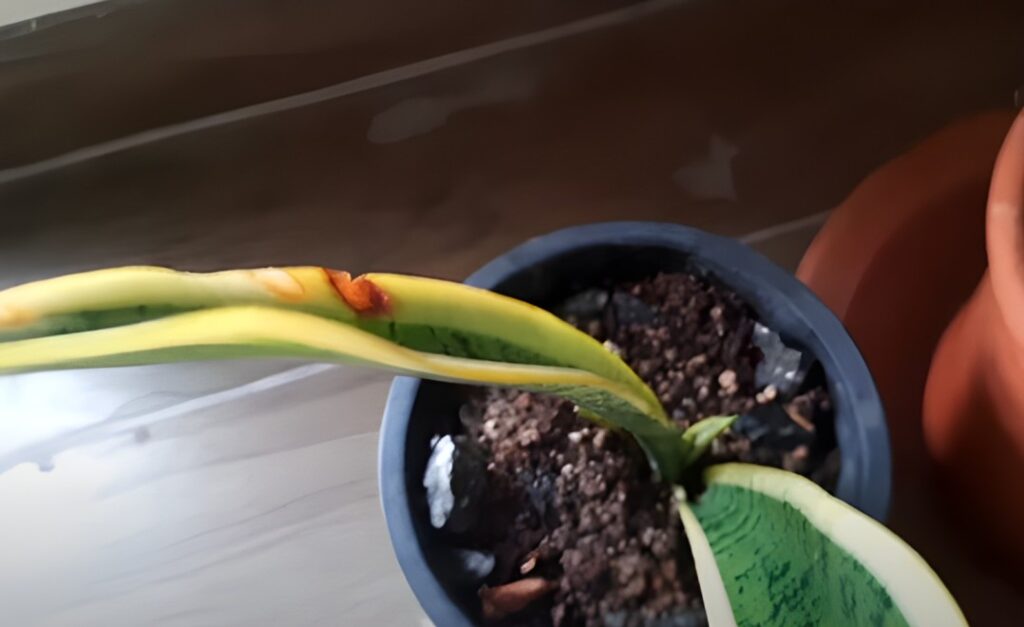
Poor Drainage
Inadequate drainage is frequently the source of brown spot on snake plants. Water buildup in the soil can cause root rot, which is followed by brown patches on the leaves.
How to Fix Poor Drainage
Make sure the soil in which your snake plant is potted has adequate drainage to avoid brown patches caused by inadequate drainage.
To prevent overwatering, use containers with drainage holes to let extra water out and let the soil dry out in between waterings. And to further enhance drainage, think about mixing in some sand or perlite with the soil mixture.
Low Light Conditions
There are several reasons why snake plants might get brown blotches, one of which being inadequate light. Insufficient light can cause dark blotches on snake plants because less chlorophyll is produced.
How to Fix Brown Spots Caused by Low Light Conditions
Move your snake plant to a brighter spot with indirect sunlight to solve this problem. Make sure it gets enough light at least 6 hours a day to encourage healthy growth and stop more brown spots.
Ensure that the plant receives equal light exposure by rotating it on a regular basis.
Excessive fertilizer
One of the most prevalent causes of brown stains on snake plants is over fertilization. Overfeeding can result in a buildup of salt in the soil, which stresses the plant and gives its leaves ugly blemishes.
How to Fix Excessive Fertilizer Damage
To solve this problem, thoroughly rinse the soil with water to remove any extra salts. After letting the plant empty fully, start up a balanced fertilization cycle, being sure to adhere to the suggested dose to prevent more issues.
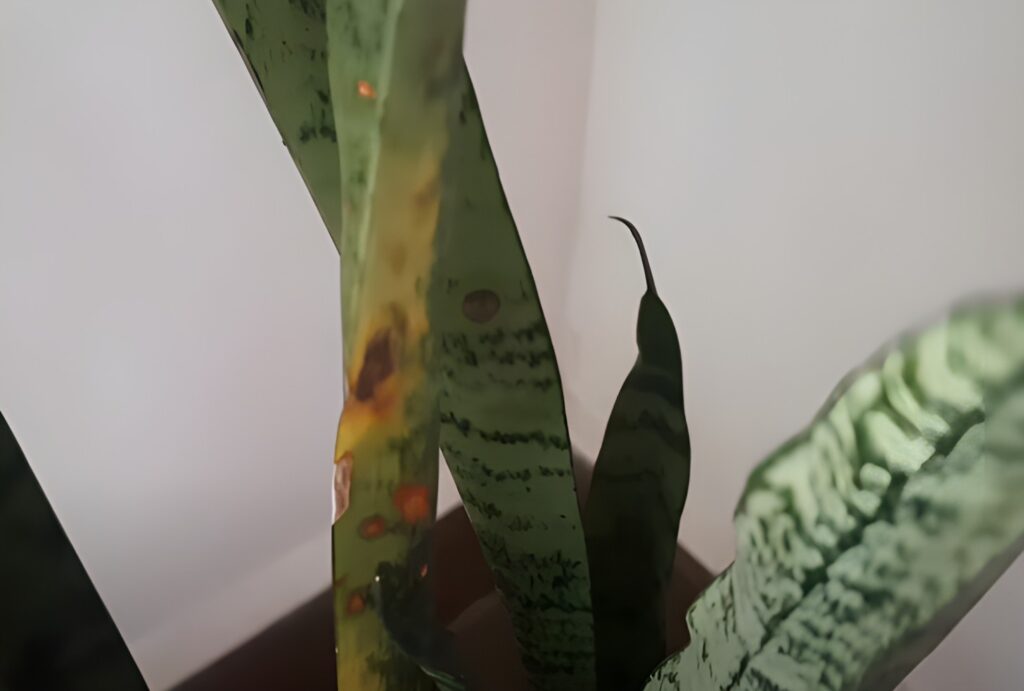
Cold temperatures
Snake plants frequently have brown blotches due to cold conditions. A plant may experience shock from cold exposure, which can result in damage and discolouration.
It’s critical to shield your snake plant from cold breezes and temperatures below 50°F (10°C) in order to address this problem. To keep the plant at the right temperature, think about moving it to a warmer location or utilizing a low-wattage heat source.
How to Fix it
Prior to treating brown spots brought on by low temperatures, evaluate the plant’s surroundings to make sure it isn’t exposed to drafts or extremely cold temperatures.
If need, relocate the plant away from windows and doors to a warmer area. For your snake plant’s health, you should also think about insulating the area or utilising a space heater to keep the temperature stable.
Red leaf spot
Red leaf spot, a fungal disease brought on by overwatering, inadequate air circulation, or usage of polluted soil, is frequently the source of brown blotches on snake plants.
Small reddish-brown lesions on the leaves are the first signs of this illness; these lesions gradually enlarge and turn dark brown.
How to Fix it
Make sure the soil dries between waterings in order to prevent red leaf spot. Increase airflow and keep plants from becoming crowded.
After removing diseased leaves, treat snake plants with a fungicide designed especially for fungal infections. To stop recurrence, regularly check and maintain plant cleanliness.
Southern Blight
There are several reasons for brown spot on snake plants, but Southern Blight is frequently to blame.
This fungal disease, which usually attacks the root of the plant and results in brown lesions, grows best in warm, humid environments.
As soon as possible, remove the impacted plant sections, make sure there is enough ventilation, and keep things from getting too crowded. Using a fungicidal treatment can also aid in the management of Southern Blight and stop its spread.
Fixing Brown Spots from Southern Blight
Use sterilised equipment to cut away any diseased sections of your snake plant in order to remedy brown patches produced by Southern Blight.
Increase the ventilation surrounding the plant to lower humidity and stop the growth of fungi. Make sure the soil has enough drainage and refrain from overwatering.
To get rid of the fungus and shield the plant from more harm, apply a fungicidal treatment designed especially for Southern Blight.
Rust
Brown spot on snake plants are frequently the result of rust, a fungal disease brought on by too much moisture and insufficient ventilation.
Water resting on the leaves due to overwatering or irrigation from above might cause this common ailment. Rust can also be introduced by exploiting contaminated soil or by importing sick plants.
Avoid overhead watering, make sure there is adequate drainage and ventilation, treat rust-affected plants with a copper-based fungicide, and prevent rust altogether.
How to Fix Brown Spot on Snake Plant
There are many processes involved in repairing rust-induced brown patches on snake plants. Prior to watering, evaluate the plant’s surroundings and make necessary adjustments to avoid over-moisture accumulation.
To prevent the growth of fungi, make sure the plant has adequate drainage and ventilation. If brown spots don’t go away, use a copper-based fungicide on the afflicted areas, being sure to properly follow the product’s directions.
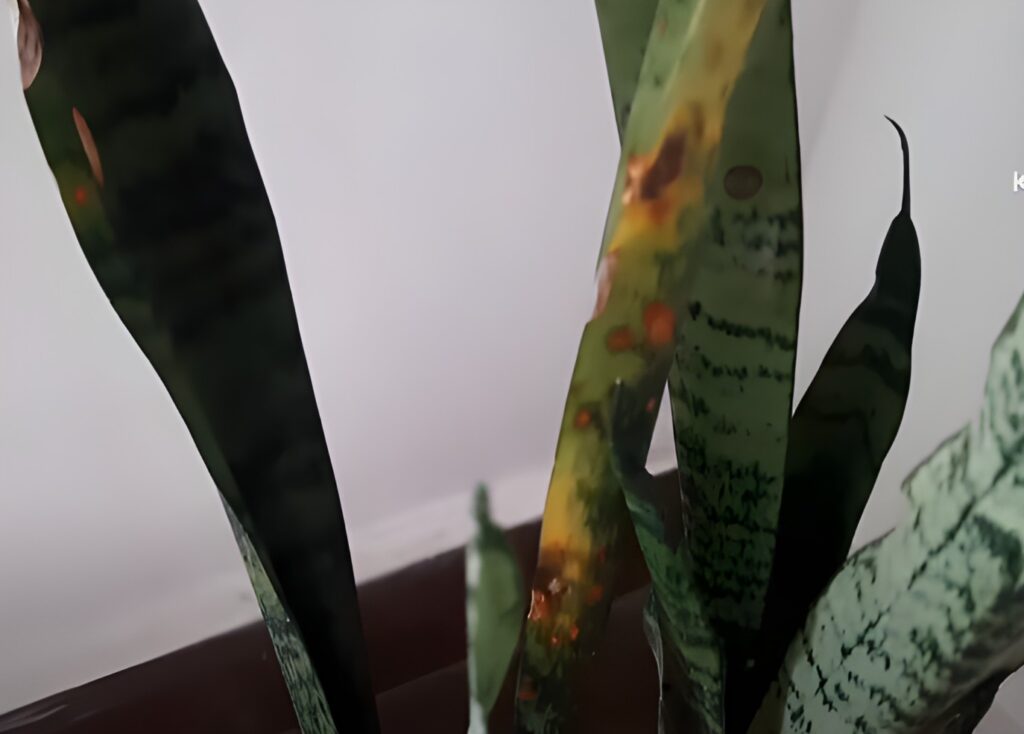
Humidity Levels
Inadequate humidity levels can lead to brown spot on snake plant leaves. Insufficient moisture in the air causes stress to the plant, resulting in leaf discoloration and browning.
How to Fix It
Use a pebble tray filled with water underneath the snake plant or place a humidifier close by to improve the humidity level surrounding the plant in order to address this problem.
Brown patches may be avoided by regularly spraying the foliage, which can also assist maintain ideal humidity levels.
Pests and Diseases
Fungal infections or insect infestations are frequently the cause of brown blotches on snake plants. Mealybugs and spider mites,
for example, can cause damage to plant tissue that results in unattractive patches. Fungal infections, which appear as brown lesions on leaves, are more common in humid environments with poorly drained soil.
How to Fix Brown Spots on Snake Plant
Use chemical or natural insecticides as advised to eradicate pests. Use a fungicide with a copper base to treat fungal infections.
To stop recurrence, make sure you hydrate and drain your garden properly, get plenty of indirect sunshine, and keep your humidity levels at their ideal range.
The diversity of snake species, from the notorious brown snakes of Australia to the elusive brown vine snake, highlights the intricacies of nature’s creations. While marveling at their characteristics, snake plant enthusiasts often face challenges, like identifying and treating brown spots that mar their plants’ leaves.
These spots, symptomatic of various ailments, including mushy or gooey textures, demand meticulous care and attention. As caretakers seek remedies and guidance, the significance of understanding snake plant diseases becomes paramount.
Amidst these concerns, the allure of a blooming snake plant flower or the curiosity surrounding its roots adds a layer of intrigue to the botanical journey.
Yet, even as brown spots persist and dreams of thriving greenery intertwine with the enigmatic realm of snake symbolism, enthusiasts remain steadfast in their commitment to nurturing these resilient plants, embodying a harmonious balance between nature’s marvels and human care.
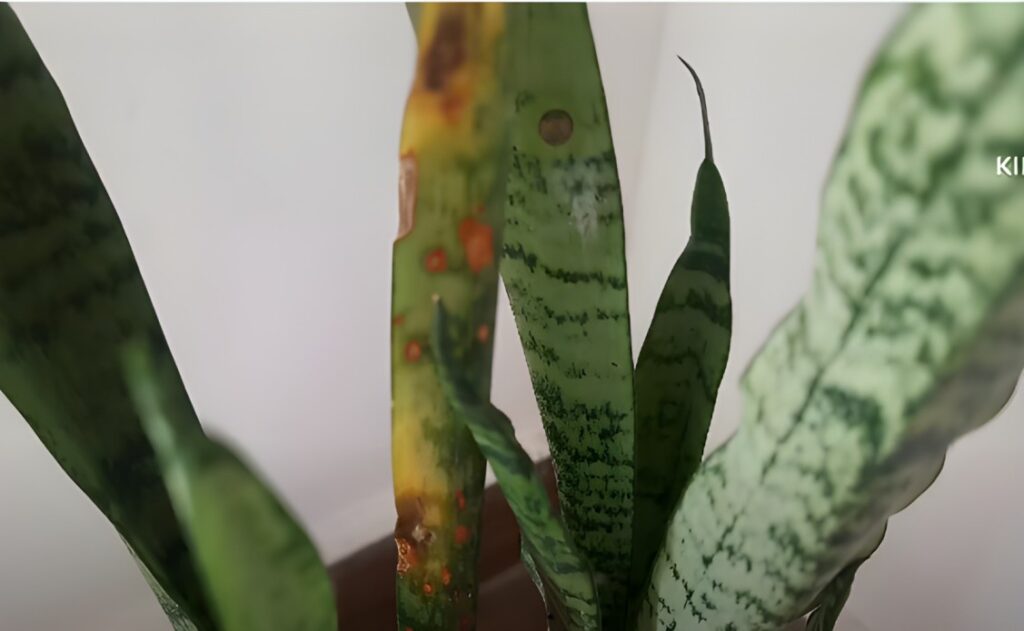
Conclusion
There are a number of reasons why snake plants may get brown patches, including as insect infestations, inadequate light, or overwatering.
In order to stop more harm and preserve the health of the plant, it is imperative that these problems are resolved very away.
You may support the growth and beautiful appearance of your snake plant by modifying your watering schedule, making sure it receives enough sunshine, and putting pest control measures in place.
FAQs
Why does my snake have brown spots?
A number of things, including overwatering, underwatering, exposure to direct sunshine, and insect infestations, can result in brown blotches on snake plants. Effective therapy requires determining the precise reason.
Should I cut the brown tips off my snake plant?
Yes, you may encourage new growth and enhance the appearance of your snake plant by pruning the brown tips off of it. Make clean cuts without harming the plant’s healthy sections as you carefully remove the afflicted regions using clean, sharp scissors.
How do you treat brown spot fungus on plants?
Using a fungicide designed to particularly target fungal diseases is the method used to treat brown spot fungus on plants.
As directed by the manufacturer, thoroughly cover all afflicted areas when applying the fungicide. To stop the fungus from spreading further, increase air circulation around the plant and refrain from watering it from above.
How do you fix brown tips on a snake plant?
Before treating brown tips on a snake plant, evaluate its watering schedule and make any necessary adjustments to guarantee the right amount of moisture.
To encourage new growth, use clean scissors to trim off the brown tips. Avoid placing the plant in direct sunlight as this might burn the foliage; instead, make sure it receives enough indirect sunlight. To stop more browning, keep humidity levels at their ideal range.

